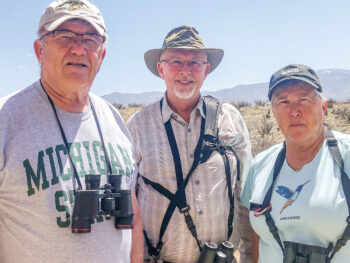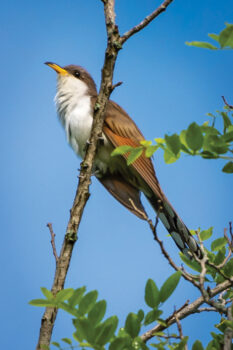
James Bradford, Jim Hoagland, and Laurie McCoy

A yellow-billed cuckoo, a summer visitor to Arizona
Jim Hoagland
The SaddleBrooke Ranch Cuckoos’ first ever Birdathon for Tucson Audubon Society was a huge success, not only financially, and a great time was had by the four team members. Thanks to the many donations and pledges from the community, family, and friends, we were able to raise over $4,800 for the Tucson Audubon to help support their mission of “Inspiring people to enjoy and protect birds through recreation, education, conservation, and restoration of the environment.” We are humbled by the continued generosity of the SaddleBrooke Ranch community.
Since it was our first year, and there was a learning curve, we modified our strategy and route for the 24-hour freestyle, counting as many birds as we could. We started our 24-hour period at 7:38 p.m. when we heard our first species, the Mexican Whip-poor-will, in Madera Canyon. We overnighted at Santa Rita Lodge and listened for more owls, hearing the Elf Owl that night.
Starting at 5:30 a.m. the next morning, we visited several areas in Madera Canyon and left the area with a total of 36 species sighted. Our next stops were Canoa Historical Ranch and Amado Water Treatment Plant, where we identified an additional 12 species, including the Black-bellied Whistling-Duck and Redhead duck.
Back on the hunt, we headed to Ina and I-10 to see the Northern Jacana, along with 10 other species.
After a quick lunch in Marana, we discovered our 60th species of our trip, a House Sparrow.
Hoping to find the Burrowing Owl on West Treatment Plant Road, we headed that way only to find a huge, blowing dust storm. But we were not disappointed for long, as we found hundreds of White-faced Ibis forging in the irrigated fields, along with Northern Harriers and Swainson’s Hawks. Knowing we needed to move on, our next stop was near the Arizona Veterans Memorial Cemetery area, where we found a Bullock’s Oriole and a Bewick’s Wren. Still hoping to find the Burrowing Owl, we scanned the irrigation ditches along Hardin Road, and, sure enough, one popped its head up.
We traveled the Santa Cruz Flats heading back to I-10, then worked our way across Park Link Drive to Oracle State Park, where we saw the Harris’s Hawk and a few other species to add to our list. Our next stop was the Mammoth Water Treatment Plant (Cielo Wastewater Treatment Plant), where the highlight was an Eared Grebe in alternate plumage.
Nearing the end of our trip, we still needed 10 more species to hit the 100 species goal, so we returned to SaddleBrooke Ranch before sunset. We checked out the pond, the trees along the pool, and the back road along golf holes number 5 and number 6 before returning to the Nature Trail in hopes of reaching our goal. Unfortunately, we came up short, only finding six species, including the Greater Roadrunner and Black-throated Sparrow.
I would like to thank my teammates, Laurie McCoy, Jim Bradford, and Kathleen Williams. Thanks again to all who donated or pledged. Happy birding.
